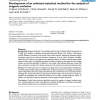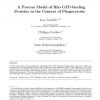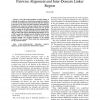BMCBI
2006
13 years 4 months ago
2006
Background: Unigenic evolution is a powerful genetic strategy involving random mutagenesis of a single gene product to delineate functionally important domains of a protein. This ...
BMCBI
2006
13 years 4 months ago
2006
Background: Hidden Markov Models (HMMs) have been extensively used in computational molecular biology, for modelling protein and nucleic acid sequences. In many applications, such...
BMCBI
2006
13 years 4 months ago
2006
Background: Methods for predicting protein function directly from amino acid sequences are useful tools in the study of uncharacterised protein families and in comparative genomic...
ENTCS
2008
13 years 4 months ago
2008
At the early stages of the phagocytic signalling, Rho GTP-binding proteins play a key role. With the stimulus from the cell membrane and with the help from the regulators (GEF, GA...
ENGL
2008
13 years 4 months ago
2008
One of the central problems in modern biology is to identify the complete set of interactions among the proteins in a cell. The structural interaction of proteins and their domains...
BMCBI
2008
13 years 4 months ago
2008
teps. First, we abstracted protein interactions onto orthologous cluster links. For a given source interaction, if both proteins belonged to a cluster, we constructed a link betwee...
BMCBI
2008
13 years 4 months ago
2008
Background: Functional annotation of proteins remains a challenging task. Currently the scientific literature serves as the main source for yet uncurated functional annotations, b...
BMCBI
2008
13 years 4 months ago
2008
Background: Prediction of transmembrane (TM) helices by statistical methods suffers from lack of sufficient training data. Current best methods use hundreds or even thousands of f...
BMCBI
2008
13 years 4 months ago
2008
Background: It has repeatedly been shown that interacting protein families tend to have similar phylogenetic trees. These similarities can be used to predicting the mapping betwee...
BMCBI
2008
13 years 4 months ago
2008
Background: Gene Ontology (GO) annotation, which describes the function of genes and gene products across species, has recently been used to predict protein subcellular and subnuc...




